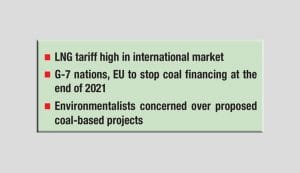
Shamim Jahangir: The government has not decided yet if it should abandon 13 coal-fired power plants as the LNG tariff is increasing steeply in the international market.
The government has taken 17 coal-fired power projects to generate around 17,000 megawatt of electricity by 2030 when the country’s electricity demand will reach 34,000 MW.
In February 2021, the Power Division sent a proposal to Prime Minister Office (PMO) to seek policy level decision about 13 coal-fired power plants. There are a total of 17 coal-fired power plants.
After a month, the PMO has sent back a proposal to scrap 13 coal-fired projects and sought clarification about the existing ratio of electricity generation from the coal-fired plants after scrapping the proposed plants, said an official.
It also sought a review of the regional grid balance.
According to the official sources, State Minister for Power and Energy Nasrul Hamid sought to scrap the projects as pressures mounted on funding for implementing the projects.
Besides, Power Secretary Md Habibur Rahman favour continuing implementation of the projects as the LNG tariff in the international market rose significantly.
According to the Rupantarita Pakratik Gas Company Ltd (RPGCL), Bangladesh purchased per mmbtu LNG at $3.8 from the spot market in September 2020, which now jumped to $10.18.
If the tariff hike will continue, Bangladesh may face trouble in balance of payment, which will push up the government’s subsidy in the coming fiscal year, an official of the RPGCL told the daily sun.
Besides, Group of Seven (G7) nations, along with several other European Union nations, have already committed to stop international financing for the coal-based power projects by the end of this year.
This is another strong step towards putting the world on a path to limit global warming to 1.5-2.0°C.
The Germany-based Siemens has already asked to Bangladesh to stop financing in future coal-fired power projects, said Power Division officials.
Power Division will meet today (Sunday) to review the proposed coal-fired power projects.
Once the meeting will okay to scrap the 13 coal-fired proposed plants, the electricity generation plan from coal-based plants will come down to only 6,079 MW from the existing plan of 16,952 MW, officials said.
The Power Division will also require PMO approval in this regard.
“I don’t understand why the government has allowed implementing the coal-fired plants at a location where there is no facility for coal transportation,” said an official on the condition of anonymity.
“It also brought more difficulties in implementing the projects. Both the bureaucrats and policymakers are responsible for it,” the official added.
He said the government might need to pay compensation to those private power producers for scrapping the projects.
A series of studies recently warned that the adverse impacts of the existing and under-construction coal-fired power could end up causing the deaths of around 71,000 people throughout their lifespan in the next 30 years, mainly due to air pollution, toxic deposition and other environmental hazards.
The studies were conducted by the Centre for Research on Energy and Clean Air (CREA) with the support of Bangladesh Poribesh Andolon (BAPA) CREA conducted the studies on eight proposed coal-fired power projects in greater Chattogram in September 2020, the newly constructed Payra coal-fired thermal power project, and proposed plants in greater Barisal in May 2020 and Rampal Power Project.
Some 16 coal-fired power plants will be responsible for the high levels of air pollution that will put the Bangladeshi population at an elevated risk from the COVID-19 pandemic, the report said.
Bangladesh Poribesh Andolon (BAPA) General Secretary Sharif Jamil said, “While publishing the report, we have called upon the authorities to scrap the coal-fired power projects for saving lives.”
Bangladesh must chalk out transition to renewable energy in its new energy master plan towards zero carbon goals, said the Institute for Energy Economics and Financial Analysis (IEEFA) in its latest report. The author of the report and energy finance analyst Simon Nicholas said the upcoming Integrated Energy and Electricity Master Plan (IEEMP), if aligned to the government’s new five-year plan, will abandon coal and increased LNG commitment in favour of cheaper low emission renewables.
“Increased reliance on expensive imported coal and LNG is a burden the government simply can’t afford to wear going forward,” he added. “Any increased reliance on coal and LNG risks seeing electricity costs for energy consumers rise even further at a time when ever-cheaper solar and wind power is available,” according to Nicholas.
Simon Nicholas drew from the 8th Five-Year Plan targeting a least-cost power generation system to provide a blueprint for developers of the new Plan, suggesting JICA should be prioritised grid investments to make better use of existing power capacity.
“Abandon the expensive pipeline of coal-fired power plants yet to begin construction and limit further additions of large power plants, meaning JICA should not provide funding for the Matarbari 2 coal power proposal – this project should be amongst those cancelled,” Nicholas said.
He recommended that the plan not replace coal power proposals with price-volatile LNG-fired power given LNG’s expense and that its full life cycle emissions are comparable to that of coal.
“Bangladesh’s five-year economic plan correctly identifies the various issues and opportunities faced by the power system. The new energy and electricity master plan being developed by Japan must now reflect this new energy reality,” said Nicholas.
Mitsubishi UFJ Financial Group, Sumitomo Mitsui Financial Group and Mizuho Financial Group announced coal exits during April and May 2021, as did the Asian Development Bank.
He added, “If JICA funds coal power and creates a plan for more high-cost LNG-fired capacity it will be worsening overcapacity and increasing the likelihood of power tariff increases for consumers.”
The 8FYP notes that the cost of power in Bangladesh rose 41 percent between FY2015 and FY2020 due to the increased use of oil and diesel in the power system’s fuel mix over the period.

